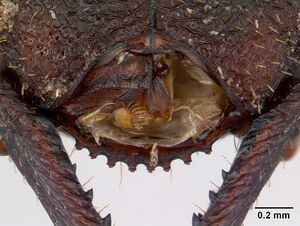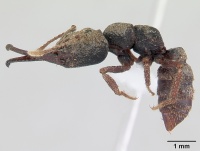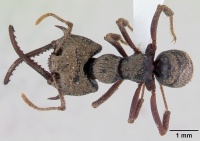Mystrium leonie
| Mystrium leonie | |
|---|---|

| |
| Scientific classification | |
| Kingdom: | Animalia |
| Phylum: | Arthropoda |
| Class: | Insecta |
| Order: | Hymenoptera |
| Family: | Formicidae |
| Subfamily: | Amblyoponinae |
| Tribe: | Amblyoponini |
| Genus: | Mystrium |
| Species group: | camillae |
| Species: | M. leonie |
| Binomial name | |
| Mystrium leonie Bihn & Verhaagh, 2007 | |
The single known specimen was extracted from a leaf litter sample taken in an old growth rainforest near Elelim.
Identification
See the beginning of the worker description given below.
Distribution
Only known from a single specimen taken near Elelim, New Guinea (Indonesia).
Latitudinal Distribution Pattern
Latitudinal Range: -3.816666667° to -3.816667°.
| North Temperate |
North Subtropical |
Tropical | South Subtropical |
South Temperate |
- Source: AntMaps
Distribution based on Regional Taxon Lists
Indo-Australian Region: New Guinea (type locality).
Distribution based on AntMaps
Distribution based on AntWeb specimens
Check data from AntWeb
Countries Occupied
| Number of countries occupied by this species based on AntWiki Regional Taxon Lists. In general, fewer countries occupied indicates a narrower range, while more countries indicates a more widespread species. |

|
Estimated Abundance
| Relative abundance based on number of AntMaps records per species (this species within the purple bar). Fewer records (to the left) indicates a less abundant/encountered species while more records (to the right) indicates more abundant/encountered species. |

|
Biology
Much of the holotype specimen, and especially the dorsum, is covered with a tightly adhering layer that is presumably soil and/or detritus. This layer in combination with the overall cryptic behavior probably acts as a camouflage for foragers in the leaf litter. Because of the lack of nest series we cannot know the reproductive strategy adopted by Mystrium leonie. But we can eliminate the possibility that the described specimen of M. leonie is not a worker but a wingless reproductive because wingless reproductives in Mystrium have reduced mandibles which are inappropriate for hunting. The holotype of M. leonie has well-developed mandibles. (Bihn & Verhaagh 2007)
|
Castes
Only known from the worker caste.
Images from AntWeb
 
| |
| Holotype of Mystrium leonie. Worker. Specimen code casent0178198. Photographer April Nobile, uploaded by California Academy of Sciences. | Owned by SMNK, Karlsruhe, Germany. |
Nomenclature
The following information is derived from Barry Bolton's Online Catalogue of the Ants of the World.
- leonie. Mystrium leonie Bihn & Verhaagh, 2007: 5, figs. 4-6, 11, 14 (w.) NEW GUINEA (Indonesia).
- Type-material: holotype worker.
- Type-locality: Indonesia: Papua Prov., Jayawijaya, nr Elelim, 03°49’S, 139°24’E, 750 m., xii.2004 (A. Riedel).
- Type-depository: MZBJ.
- Distribution: Indonesia (Papua).
Unless otherwise noted the text for the remainder of this section is reported from the publication that includes the original description.
Description
Worker
Measurements and indices. Holotype worker: HL 2.26, HW 2.45, CI 108, SL 1.63, SI 66, ML 2.80, WL 2.50, PW 1.18.
The following character combination differentiates M. leonie from all its congeners: the apex of each mandible only slightly expanded and subtruncate; outer face of labrum with an irregular rugoreticulum; maxillary palps 3-segmented; the second segment of the maxillary palp longer than the basal (first) and third segment, respectively; antennal segment III at least twice as long as broad; antennal scape broadened in its distal part, this part ventrally tapering into a lamella; each anterolateral corner of the head produced into a long and pointed spine; dorsum of head with rugose-reticulate cuticular sculpture and clavate hairs; minute compound eyes.
General morphology of worker as shown in figures 4–6. Head wider than long; posterior margin of head in full-face view deeply and roundly emarginate. Each anterolateral corner of head produced into a forward directed, long and curved spine. Mandibles long and slender, basal 2/3 straight, distal 1/3 incurved; the inner margin with two staggered, longitudinal rows of hamulus-like teeth, each row with 14 teeth; the teeth of the lower row larger than those of the upper row; the apex of each mandible only slightly expanded and subtruncate; the medioventral corner of the apex with an additional tooth; distal 3/4 on dorsal side and distal half on ventral side of each mandible with a longitudinal carina.
Labrum (fig. 14) about twice as wide as long; its distal margin convex with a median, broad emargination; outer (ventral) face of labrum entirely foveolate-reticulate, and partly overlaid by an irregular rugoreticulum; this rugoreticulum is restricted to the distal half of the outer face of the labrum.
Maxillary palps 3-segmented (fig. 11); the second segment longer than the basal (first) and the distal (third) segment; basal (first) segment cylindrical, its diameter only slightly larger than the diameter of the second segment. Labial palps 3-segmented.
Anterior clypeal margin convex with 8 truncated teeth; the teeth evenly spaced along the clypeal margin, without a median toothless gap. Antennal scape (antennal segment I) in dorsal view (as in fig. 4) curved only weakly in its distal part, distal part broadened; in frontal view (perpendicular to dorsal view) scape evenly curved with its predistal part broadened ventrally, tapering into a lamella, apex of scape bends dorsad thus forming a concavity on the dorsal side of the scape. Each of antennal segments II–VIII longer than broad; antennal segment III at least twice as long as broad; antennal segments IX–XII (the four distal segments) forming a weak club. Compound eyes minute, consisting of 7–10 ommatidia, situated near the midpoint of the sides of the head.
In lateral view, the dorsal outline of the mesosoma almost flat; promesonotal suture wide and deeply depressed, metanotal groove indistinct. Mesosoma in dorsal view distinctly constricted between pronotum and propodeum. Propodeal spiracle directed laterocaudad. Hind tarsus, when five tarsal segments combined, only slightly longer than hind tibia. Petiolar node in dorsal view more than twice as broad as long. Subpetiolar process expanded anteroventrally and forming a rounded apex. Gastral segment I less than twice as broad as long, nearly as broad as segment II.
Head and posterior face of propodeum, dorsa of mesosoma, petiolar node and gastral segment I rugose-reticulate; anterodorsal part of head between scape insertion and lateral spine with longitudinal rugae; outer face of each mandible with evenly spaced, oblique rugae; distal part of antennal scape with strong rugae; coxae with strong rugae; dorsa of gastral segments I and II with longitudinal rugae, which are sparsely interconnected by transverse ridges; rugae finer on gastral segment II than on segment I; helcium and girdling constriction of gastral segment II scrobiculate. Intervals between rugae with fine foveolate-reticulate microsculpture; strength of microsculpture varies greatly among body parts: distinct on anterodorsal and mediodorsal faces of head, on lateral faces of mesosoma, in promesonotal depression, on posterior face of propodeum, on anterior face of petiole, on all gastral segments including the presclerites and on legs; microsculpture on posterodorsal and ventral faces of head, and on dorsa of mesosoma and petiolar node very shallow and obscure, i.e. these areas nearly smooth (the less-microsculptured areas were mostly hidden under soil particles, that stuck on the integument [or possibly a mixture of soil particles and integumental secretion], and became visible only after cleaning).
Dorsum of head, antennal scape, antennal segments II–VIII, mesosoma, petiole and dorsum of gaster with decumbent to suberect, bluntly pointed, clavate setae; posterodorsal margin of gastral segments I–IV with a row of subdecumbent, longer and narrower clavate setae; pygidium with both clavate and simple hairs; setae on ventral face of head appressed and simple; hairs on ventrum of gaster subdecumbent and simple; antennal segments IX–XII densely covered with decumbent, simple hairs and a few simple, erect hairs.
Most body parts dark brown to black, except for anterior part of head, mandibles, antennae and gaster which are of a variable lighter, rusty brown color; coloration of legs changing gradually from black coxae to yellow brown distal tarsal segments; integument mostly dull, but the less-microsculptured areas somewhat shining.
Type Material
Holotype: Worker. INDONESIA: Papua Province, Jayawijaya, near Elelim, 03°49' S, 139°24' E, 750m a.s.l., December 2004 (leg. A. Riedel), deposited at MZB.
Etymology
Named in dedication to Leonie Geeltje Aimée Wiegel, the daughter of M. Verhaagh, being as unique as this species known from a single specimen. The specific epithet is to be treated as a noun in apposition.
References
References based on Global Ant Biodiversity Informatics
- Bihn J.H., and M. Verhaagh. 2007. A review of the genus Mystrium (Hymenoptera: Formicidae) in the Indo Australian region. Zootaxa 1642: 1-12.
- Bihn, J. H., and M. Verhaagh. "A review of the genus Mystrium (Hymenoptera: Formicidae) in the Indo-Australian region." Zootaxa 1642 (2007): 1-12.
- Janda M., G. D. Alpert, M. L. Borowiec, E. P. Economo, P. Klimes, E. Sarnat, and S. O. Shattuck. 2011. Cheklist of ants described and recorded from New Guinea and associated islands. Available on http://www.newguineants.org/. Accessed on 24th Feb. 2011.

